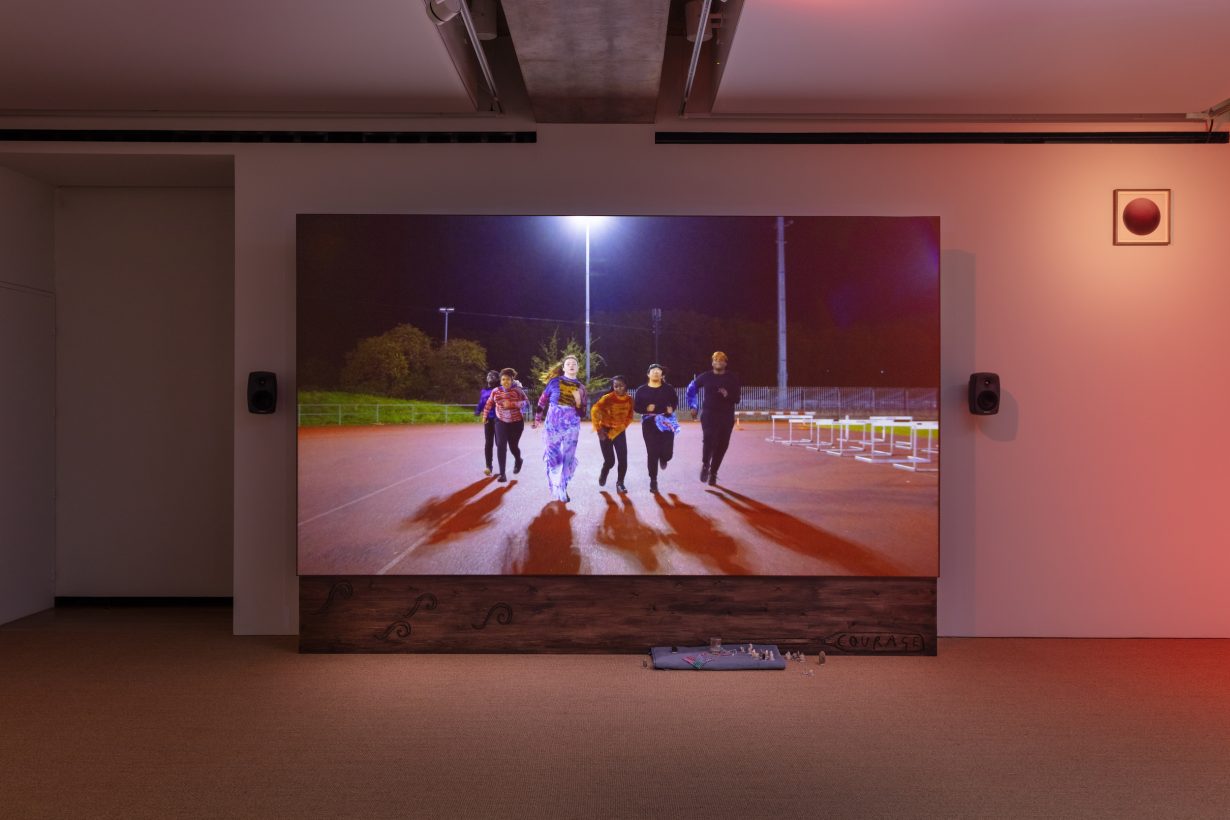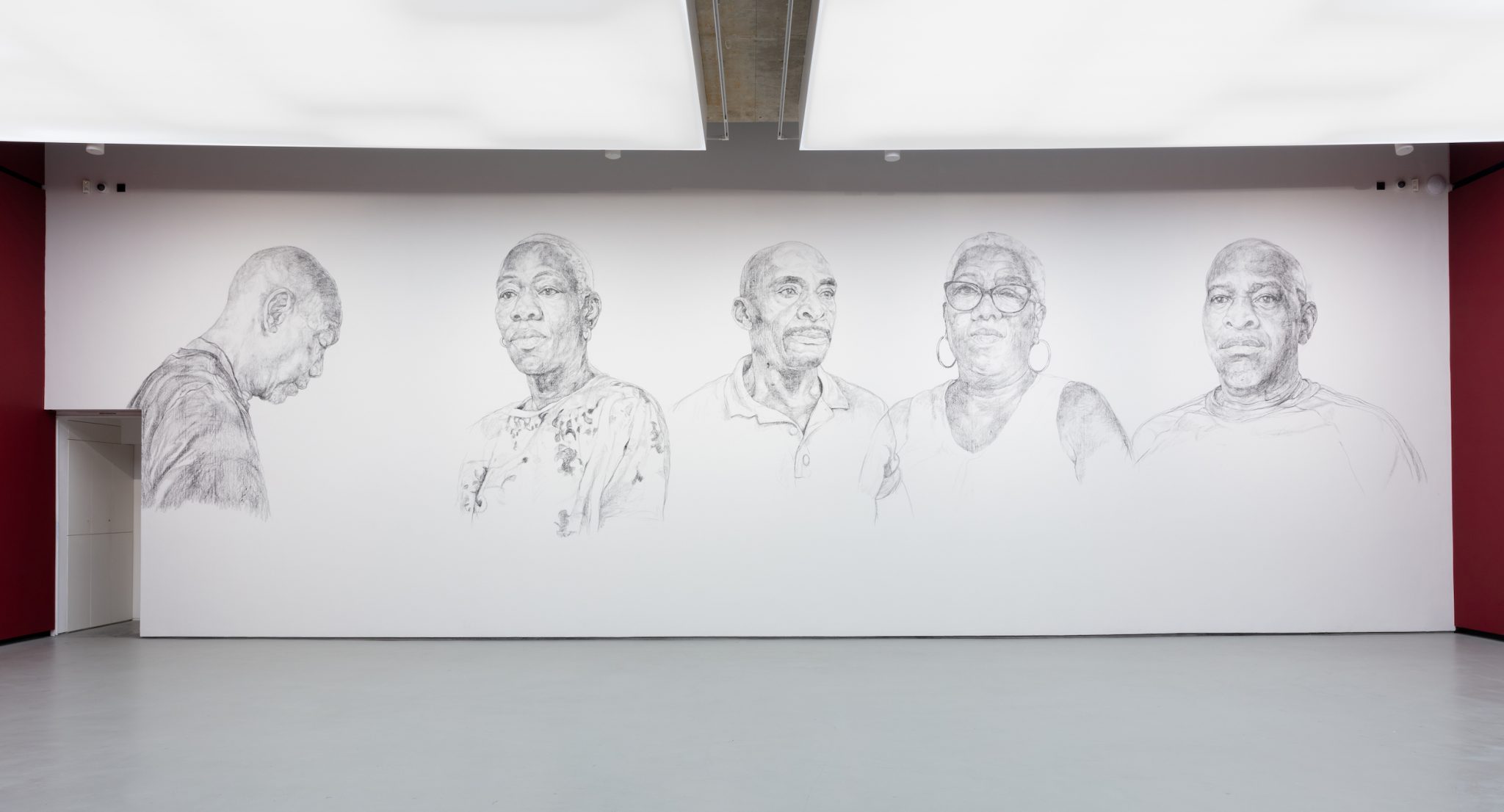The four nominated artists explore the power of community to bind and divide
The Turner Prize 2023 exhibition, held at Towner Eastbourne, may be the first edition in a few years taking place when things, at least pandemic-wise, feel ‘back to normal’. However, as the range of works by the four artists nominated for this year’s Turner Prize demonstrate, ‘normal’ can feel just as disorienting as the upheaval that preceded it. The artists each exhibit works that explore different facets of this uneasy normal – political, social, economic – through a range of media including installation, drawing, sculpture and film. However, the throughline connecting this range of practices is the idea of community. For Ghislaine Leung and Rory Pilgrim, community can facilitate support and empathy. Jesse Darling and Barbara Walker explore its rough, blemished side, which, especially when considered in a nationalistic sense, can be alienating and destructive. Another throughline in the artists’ works is their response to the effects of recent or ongoing experiences. Pilgrim and Leung take a more personal route, focusing on how community influences the individual experiences of the pandemic and motherhood, respectively. Darling, whose work considers the aftermath of Brexit, and Walker who examines the Windrush scandal, contemplate how national policies can damage the communities they are meant to serve.

For Leung, community is baked into her process. Her presentation featured five of her Scores, text-based instructions or descriptions that are realised by the gallery team in close conversation with the artist. The works, all initially shown at her nominated solo exhibition at Simian in Copenhagen, adapt to the space, but are meant to follow the function Leung has predetermined in the initial score. Fountains (2022) is meant to cancel sound in the exhibition space. In its Copenhagen iteration, this was achieved by water pouring dramatically from the ceiling to the floor. The Eastbourne version, which involves water springing up from the centre of a metal tub, feels tame in comparison although it still accomplishes its objective. Other works, like Hours (2022), allude to a community beyond the gallery space. The work is a grid painted onto the gallery wall, which is divided into the hours of the week, with the hours available to Leung to make art – 9:00 to 16:00 on Thursdays and Fridays – painted in black. These are the times Leung takes away from her other work, which includes parenting. Keeping this schedule, and fulfilling her multiple duties, involves the support of others. Leung’s work demonstrates that these bonds are symbiotic. They sustain, albeit in varying ways, the artist and the networks of people that ripple out around her. Leung’s work is an understated ode to what happens and who works behind the scenes to keep things going.

Pilgrim takes a more granular approach to community, considering the individuals that form and expand it. The main work in his exhibition space is an hour-long film, RAFTS (2021), which documents a project of the same name produced during the pandemic in collaboration with Green Shoes Arts, a charity that engages the residents of East London Borough of Barking and Dagenham in artistic activities. The project had participants consider the idea of a raft as a support structure and respond using poetry, music and storytelling. The film splices the participants’ musings on rafts in relation to their experiences of the pandemic, intercut between recordings of songs performed at London’s Cadogan Hall. The music is beautifully performed by singers including Robyn Haddon, Declan Rowe John, and Kayden Fearon with accompaniment from London Contemporary Orchestra. The participants’ additions can feel quite sentimental at first, but over time they become gripping reminders of how difficult and life-changing the pandemic was. Moreover, these excerpts underscore that there was only one way we could have kept afloat at the time and eventually come out the other end: together.

To enter the two galleries housing Darling’s and Walker’s works, visitors must first pass under a barbed wire arch constructed by Darling and envisioned as a checkpoint. Here the idea of ‘us and them’, the included and excluded, begins: community turned ugly. Beneath the barbed wire hangs a sheer, white, embroidered net curtain. The materials Darling uses to designate this threshold don’t feel right together – the wire connotes the public, the outdoor and the punitive, while the curtain alludes to a space that is domestic, private, gentle. Yet, both are used at the peripheries of home, whether a house or a country.
After crossing through and entering the gallery, there are two lines of metal barricades that border a set path forward into the space that widen and eventually dissolve, doing away with the order and control suggested by the checkpoint behind them. What fills Darling’s gallery feels like the ruins of a nationalistic ideology of exclusion. There is bunting with ragged and faded Union Jacks, binders stuffed with concrete – seemingly official, but essentially nonsensical – and a railing that has punched through a wall and mapped a writhing path mid-air before splaying out on the floor. The enactment of Brexit in 2020 and its ongoing impacts, for individual households in the UK and the country’s population as a whole, makes this work cut particularly deep. In one corner, two barricades, each with elongated metal rods at their bases, are positioned in the corner. They look as if they have sprouted legs and are trying to climb the walls to escape. There is an anthropomorphic element in several of Darling’s works: these barricades have become animated with feelings and desires. The mechanisms which facilitate exclusion and inclusion in communities, domestic or public, are not objective. As neutral as binders, barricades and banners may appear, when pushed to deliver the extremes of nationalistic self-preservation, they self-destruct, revealing a logic that is absurd, human or sometimes a mix of both.

The clash between nation and humanity continues in Walker’s exhibition. Moving past Darling’s second checkpoint and through a short corridor connecting the two galleries, a mural depicting five large-scale charcoal portraits towers in the distance. All the portraits in Walker’s show, which includes these wall drawings along with works on paper, depict people impacted by the Windrush scandal, which surfaced in 2017. It involved the wrongful deportation and denial of legal rights to UK nationals who had migrated from Caribbean Commonwealth countries prior to 1973 because they did not have paperwork to show their British citizenship, which was assumed at the time of their arrival because they were citizens of British territories. The works on paper feature drawings of the documents that allowed the subjects of the portraits to challenge, and ultimately overturn, the government’s assertion that they were foreigners with no right to reside in the UK. These large portraits remind viewers that Walker’s subjects are larger than, more than these events. However, as the smaller portraits on paper show, the experience has become embedded in who they are. The documents are either the background of the portraits, or they overlap, bisecting faces in some instances, rather than placed beside her subjects. Although government bureaucracy, and the administration of delineating who does and does not have rights to be part of the national community, can seem complex and opaque, its design and impacts are human. Her work straightforwardly emphasises the severity of what can happen when this is forgotten.
Community has the power to both bind and divide; all four artists seem to agree on that. The events that their work references speak to issues that involve most people, if not directly then indirectly through the many communities to which we belong. Whether joyful or unpleasant, there is solace in knowing that we are not alone. Perhaps this is the essence of our current normal. Regardless who wins, for better or worse, we’re in this together.
Salena Barry is a writer living and working in London, UK. She is a 2022 Jerwood Writer in Residence.
